Marks & Spencer Strategic Management: Evaluating Business Strategy
VerifiedAdded on 2024/06/11
|22
|5440
|157
Report
AI Summary
This report provides a strategic management analysis of Marks and Spencer (M&S), a multinational retail organization dealing in clothes, luxury food, and home products. It explores the company's mission, vision, goals, and objectives, proposing new statements to enhance their strategic direction. The analysis includes macro and microenvironment assessments using PESTEL and the New 8 Force Model, identifying opportunities and threats. The report delves into political, economic, socio-cultural, technological, environmental, and legal factors affecting M&S, along with industry-specific drivers like digitalization, globalization, and deregulation. It references the 'Plan A' initiative and suggests strategic mapping of services to address organizational challenges and improve business performance, highlighting the importance of adapting to market changes and consumer preferences.
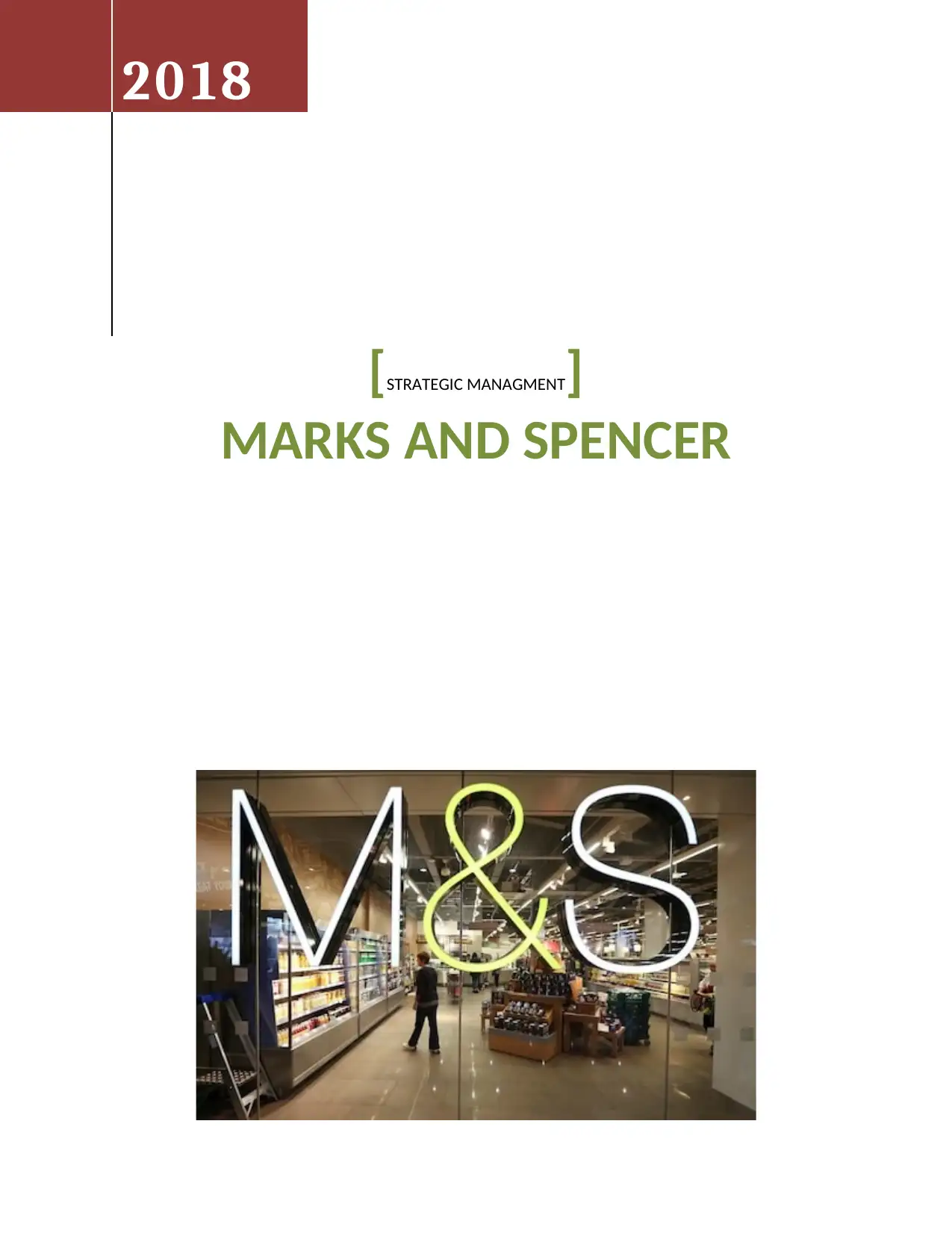
[STRATEGIC MANAGMENT]
MARKS AND SPENCER
2018
MARKS AND SPENCER
2018
Paraphrase This Document
Need a fresh take? Get an instant paraphrase of this document with our AI Paraphraser
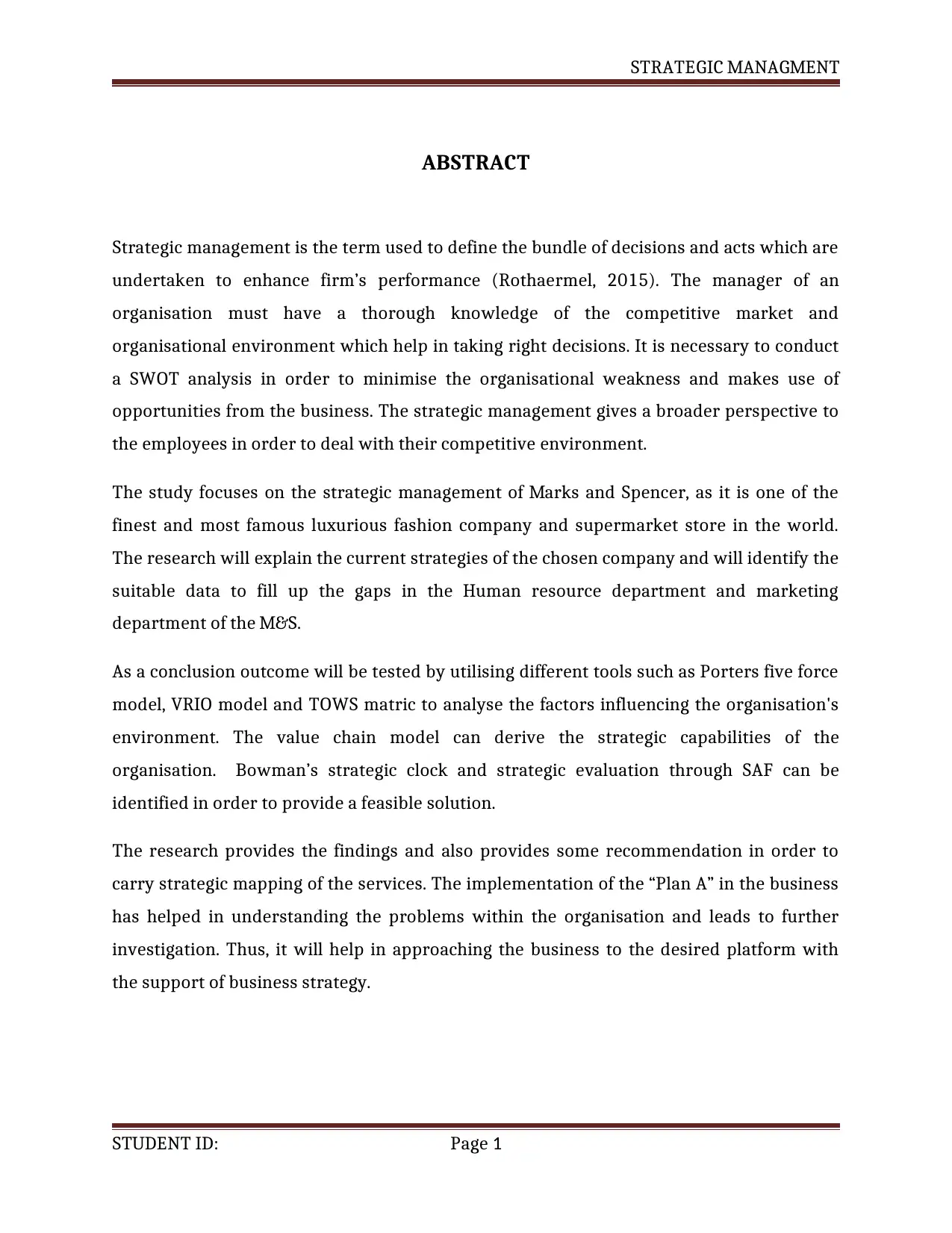
STRATEGIC MANAGMENT
ABSTRACT
Strategic management is the term used to define the bundle of decisions and acts which are
undertaken to enhance firm’s performance (Rothaermel, 2015). The manager of an
organisation must have a thorough knowledge of the competitive market and
organisational environment which help in taking right decisions. It is necessary to conduct
a SWOT analysis in order to minimise the organisational weakness and makes use of
opportunities from the business. The strategic management gives a broader perspective to
the employees in order to deal with their competitive environment.
The study focuses on the strategic management of Marks and Spencer, as it is one of the
finest and most famous luxurious fashion company and supermarket store in the world.
The research will explain the current strategies of the chosen company and will identify the
suitable data to fill up the gaps in the Human resource department and marketing
department of the M&S.
As a conclusion outcome will be tested by utilising different tools such as Porters five force
model, VRIO model and TOWS matric to analyse the factors influencing the organisation's
environment. The value chain model can derive the strategic capabilities of the
organisation. Bowman’s strategic clock and strategic evaluation through SAF can be
identified in order to provide a feasible solution.
The research provides the findings and also provides some recommendation in order to
carry strategic mapping of the services. The implementation of the “Plan A” in the business
has helped in understanding the problems within the organisation and leads to further
investigation. Thus, it will help in approaching the business to the desired platform with
the support of business strategy.
STUDENT ID: Page 1
ABSTRACT
Strategic management is the term used to define the bundle of decisions and acts which are
undertaken to enhance firm’s performance (Rothaermel, 2015). The manager of an
organisation must have a thorough knowledge of the competitive market and
organisational environment which help in taking right decisions. It is necessary to conduct
a SWOT analysis in order to minimise the organisational weakness and makes use of
opportunities from the business. The strategic management gives a broader perspective to
the employees in order to deal with their competitive environment.
The study focuses on the strategic management of Marks and Spencer, as it is one of the
finest and most famous luxurious fashion company and supermarket store in the world.
The research will explain the current strategies of the chosen company and will identify the
suitable data to fill up the gaps in the Human resource department and marketing
department of the M&S.
As a conclusion outcome will be tested by utilising different tools such as Porters five force
model, VRIO model and TOWS matric to analyse the factors influencing the organisation's
environment. The value chain model can derive the strategic capabilities of the
organisation. Bowman’s strategic clock and strategic evaluation through SAF can be
identified in order to provide a feasible solution.
The research provides the findings and also provides some recommendation in order to
carry strategic mapping of the services. The implementation of the “Plan A” in the business
has helped in understanding the problems within the organisation and leads to further
investigation. Thus, it will help in approaching the business to the desired platform with
the support of business strategy.
STUDENT ID: Page 1
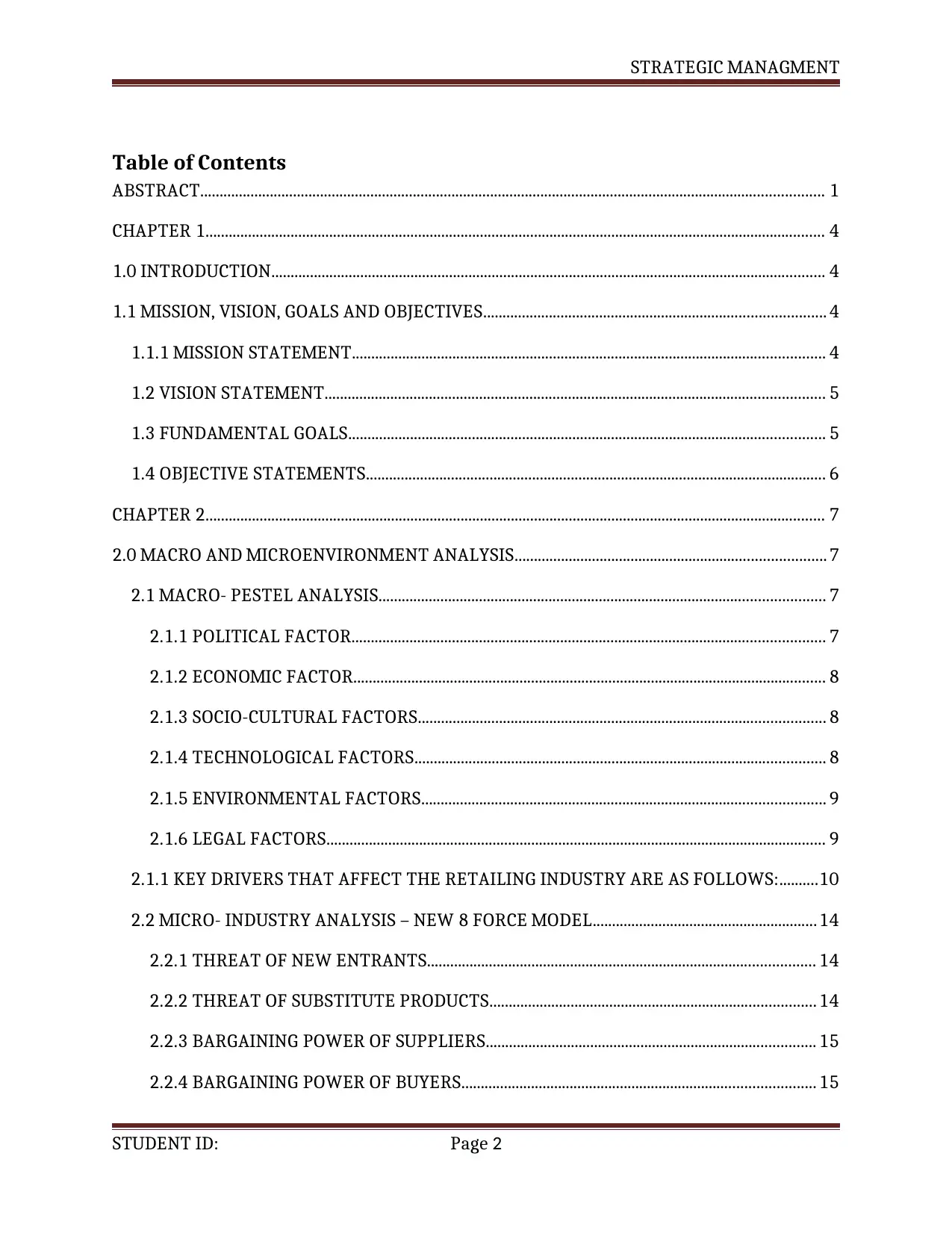
STRATEGIC MANAGMENT
Table of Contents
ABSTRACT................................................................................................................................................................. 1
CHAPTER 1................................................................................................................................................................ 4
1.0 INTRODUCTION............................................................................................................................................... 4
1.1 MISSION, VISION, GOALS AND OBJECTIVES........................................................................................ 4
1.1.1 MISSION STATEMENT.......................................................................................................................... 4
1.2 VISION STATEMENT................................................................................................................................. 5
1.3 FUNDAMENTAL GOALS........................................................................................................................... 5
1.4 OBJECTIVE STATEMENTS....................................................................................................................... 6
CHAPTER 2................................................................................................................................................................ 7
2.0 MACRO AND MICROENVIRONMENT ANALYSIS................................................................................ 7
2.1 MACRO- PESTEL ANALYSIS................................................................................................................... 7
2.1.1 POLITICAL FACTOR.......................................................................................................................... 7
2.1.2 ECONOMIC FACTOR.......................................................................................................................... 8
2.1.3 SOCIO-CULTURAL FACTORS......................................................................................................... 8
2.1.4 TECHNOLOGICAL FACTORS.......................................................................................................... 8
2.1.5 ENVIRONMENTAL FACTORS........................................................................................................ 9
2.1.6 LEGAL FACTORS................................................................................................................................. 9
2.1.1 KEY DRIVERS THAT AFFECT THE RETAILING INDUSTRY ARE AS FOLLOWS:..........10
2.2 MICRO- INDUSTRY ANALYSIS – NEW 8 FORCE MODEL..........................................................14
2.2.1 THREAT OF NEW ENTRANTS.................................................................................................... 14
2.2.2 THREAT OF SUBSTITUTE PRODUCTS.................................................................................... 14
2.2.3 BARGAINING POWER OF SUPPLIERS..................................................................................... 15
2.2.4 BARGAINING POWER OF BUYERS........................................................................................... 15
STUDENT ID: Page 2
Table of Contents
ABSTRACT................................................................................................................................................................. 1
CHAPTER 1................................................................................................................................................................ 4
1.0 INTRODUCTION............................................................................................................................................... 4
1.1 MISSION, VISION, GOALS AND OBJECTIVES........................................................................................ 4
1.1.1 MISSION STATEMENT.......................................................................................................................... 4
1.2 VISION STATEMENT................................................................................................................................. 5
1.3 FUNDAMENTAL GOALS........................................................................................................................... 5
1.4 OBJECTIVE STATEMENTS....................................................................................................................... 6
CHAPTER 2................................................................................................................................................................ 7
2.0 MACRO AND MICROENVIRONMENT ANALYSIS................................................................................ 7
2.1 MACRO- PESTEL ANALYSIS................................................................................................................... 7
2.1.1 POLITICAL FACTOR.......................................................................................................................... 7
2.1.2 ECONOMIC FACTOR.......................................................................................................................... 8
2.1.3 SOCIO-CULTURAL FACTORS......................................................................................................... 8
2.1.4 TECHNOLOGICAL FACTORS.......................................................................................................... 8
2.1.5 ENVIRONMENTAL FACTORS........................................................................................................ 9
2.1.6 LEGAL FACTORS................................................................................................................................. 9
2.1.1 KEY DRIVERS THAT AFFECT THE RETAILING INDUSTRY ARE AS FOLLOWS:..........10
2.2 MICRO- INDUSTRY ANALYSIS – NEW 8 FORCE MODEL..........................................................14
2.2.1 THREAT OF NEW ENTRANTS.................................................................................................... 14
2.2.2 THREAT OF SUBSTITUTE PRODUCTS.................................................................................... 14
2.2.3 BARGAINING POWER OF SUPPLIERS..................................................................................... 15
2.2.4 BARGAINING POWER OF BUYERS........................................................................................... 15
STUDENT ID: Page 2
⊘ This is a preview!⊘
Do you want full access?
Subscribe today to unlock all pages.

Trusted by 1+ million students worldwide
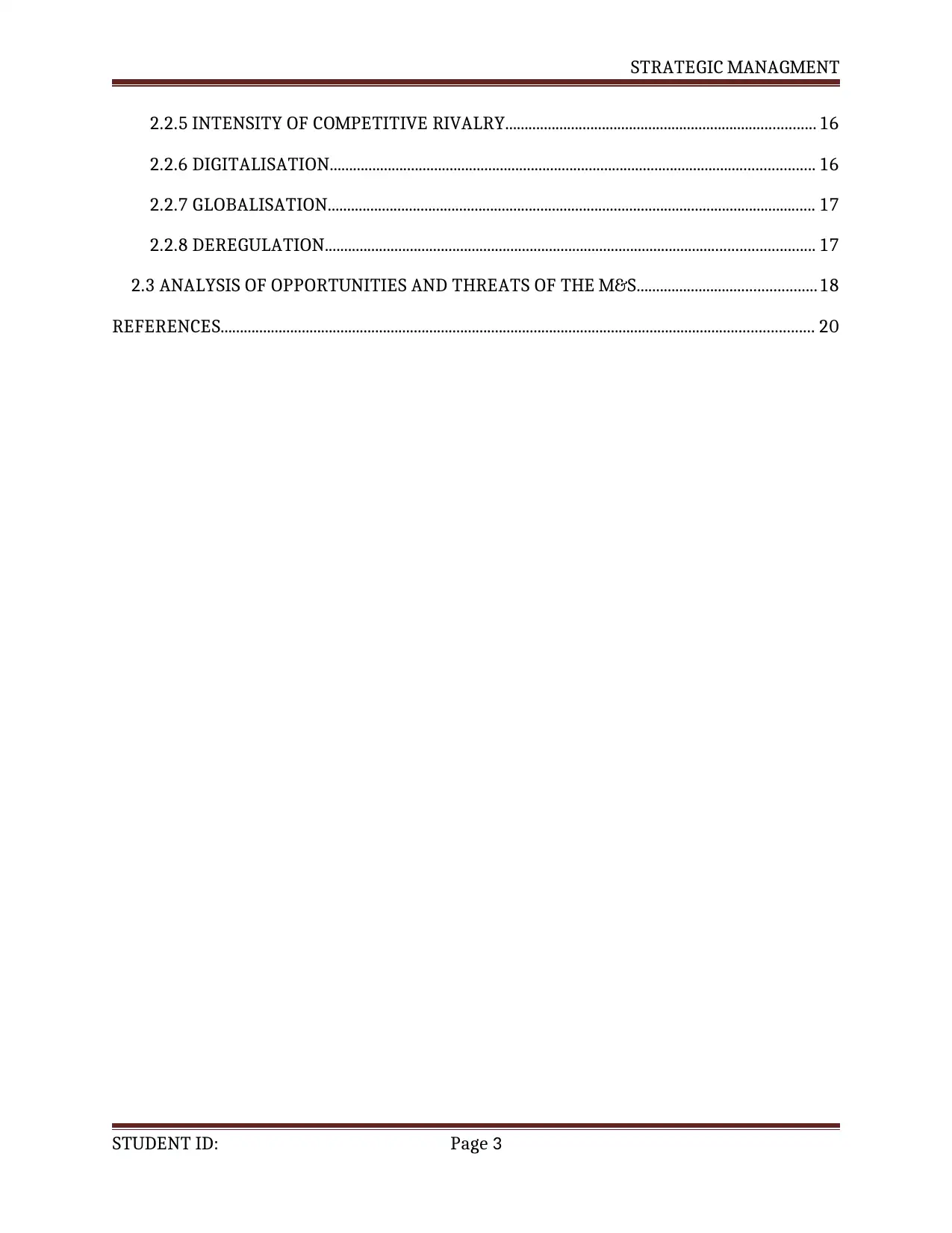
STRATEGIC MANAGMENT
2.2.5 INTENSITY OF COMPETITIVE RIVALRY................................................................................ 16
2.2.6 DIGITALISATION............................................................................................................................. 16
2.2.7 GLOBALISATION.............................................................................................................................. 17
2.2.8 DEREGULATION.............................................................................................................................. 17
2.3 ANALYSIS OF OPPORTUNITIES AND THREATS OF THE M&S..............................................18
REFERENCES......................................................................................................................................................... 20
STUDENT ID: Page 3
2.2.5 INTENSITY OF COMPETITIVE RIVALRY................................................................................ 16
2.2.6 DIGITALISATION............................................................................................................................. 16
2.2.7 GLOBALISATION.............................................................................................................................. 17
2.2.8 DEREGULATION.............................................................................................................................. 17
2.3 ANALYSIS OF OPPORTUNITIES AND THREATS OF THE M&S..............................................18
REFERENCES......................................................................................................................................................... 20
STUDENT ID: Page 3
Paraphrase This Document
Need a fresh take? Get an instant paraphrase of this document with our AI Paraphraser
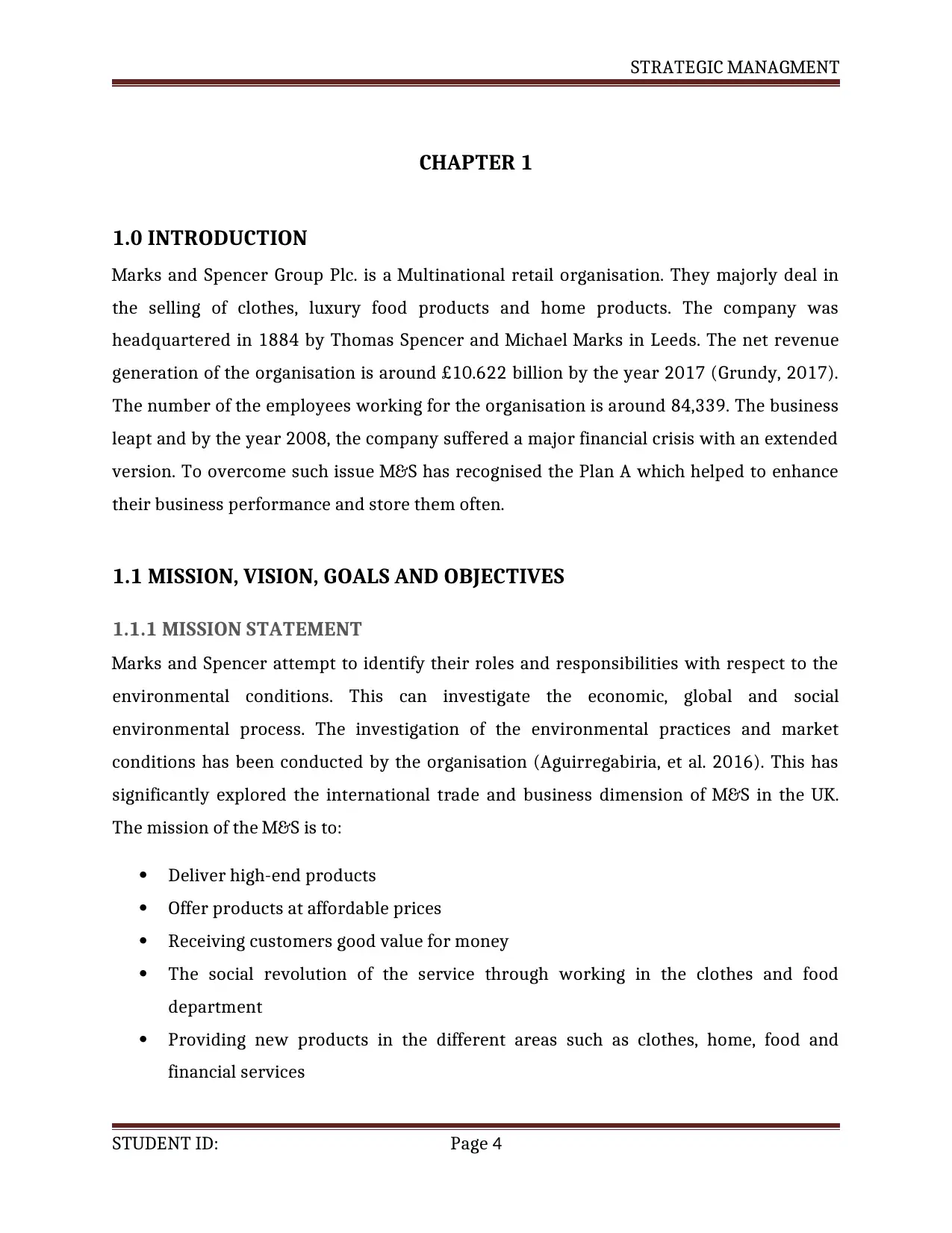
STRATEGIC MANAGMENT
CHAPTER 1
1.0 INTRODUCTION
Marks and Spencer Group Plc. is a Multinational retail organisation. They majorly deal in
the selling of clothes, luxury food products and home products. The company was
headquartered in 1884 by Thomas Spencer and Michael Marks in Leeds. The net revenue
generation of the organisation is around £10.622 billion by the year 2017 (Grundy, 2017).
The number of the employees working for the organisation is around 84,339. The business
leapt and by the year 2008, the company suffered a major financial crisis with an extended
version. To overcome such issue M&S has recognised the Plan A which helped to enhance
their business performance and store them often.
1.1 MISSION, VISION, GOALS AND OBJECTIVES
1.1.1 MISSION STATEMENT
Marks and Spencer attempt to identify their roles and responsibilities with respect to the
environmental conditions. This can investigate the economic, global and social
environmental process. The investigation of the environmental practices and market
conditions has been conducted by the organisation (Aguirregabiria, et al. 2016). This has
significantly explored the international trade and business dimension of M&S in the UK.
The mission of the M&S is to:
Deliver high-end products
Offer products at affordable prices
Receiving customers good value for money
The social revolution of the service through working in the clothes and food
department
Providing new products in the different areas such as clothes, home, food and
financial services
STUDENT ID: Page 4
CHAPTER 1
1.0 INTRODUCTION
Marks and Spencer Group Plc. is a Multinational retail organisation. They majorly deal in
the selling of clothes, luxury food products and home products. The company was
headquartered in 1884 by Thomas Spencer and Michael Marks in Leeds. The net revenue
generation of the organisation is around £10.622 billion by the year 2017 (Grundy, 2017).
The number of the employees working for the organisation is around 84,339. The business
leapt and by the year 2008, the company suffered a major financial crisis with an extended
version. To overcome such issue M&S has recognised the Plan A which helped to enhance
their business performance and store them often.
1.1 MISSION, VISION, GOALS AND OBJECTIVES
1.1.1 MISSION STATEMENT
Marks and Spencer attempt to identify their roles and responsibilities with respect to the
environmental conditions. This can investigate the economic, global and social
environmental process. The investigation of the environmental practices and market
conditions has been conducted by the organisation (Aguirregabiria, et al. 2016). This has
significantly explored the international trade and business dimension of M&S in the UK.
The mission of the M&S is to:
Deliver high-end products
Offer products at affordable prices
Receiving customers good value for money
The social revolution of the service through working in the clothes and food
department
Providing new products in the different areas such as clothes, home, food and
financial services
STUDENT ID: Page 4
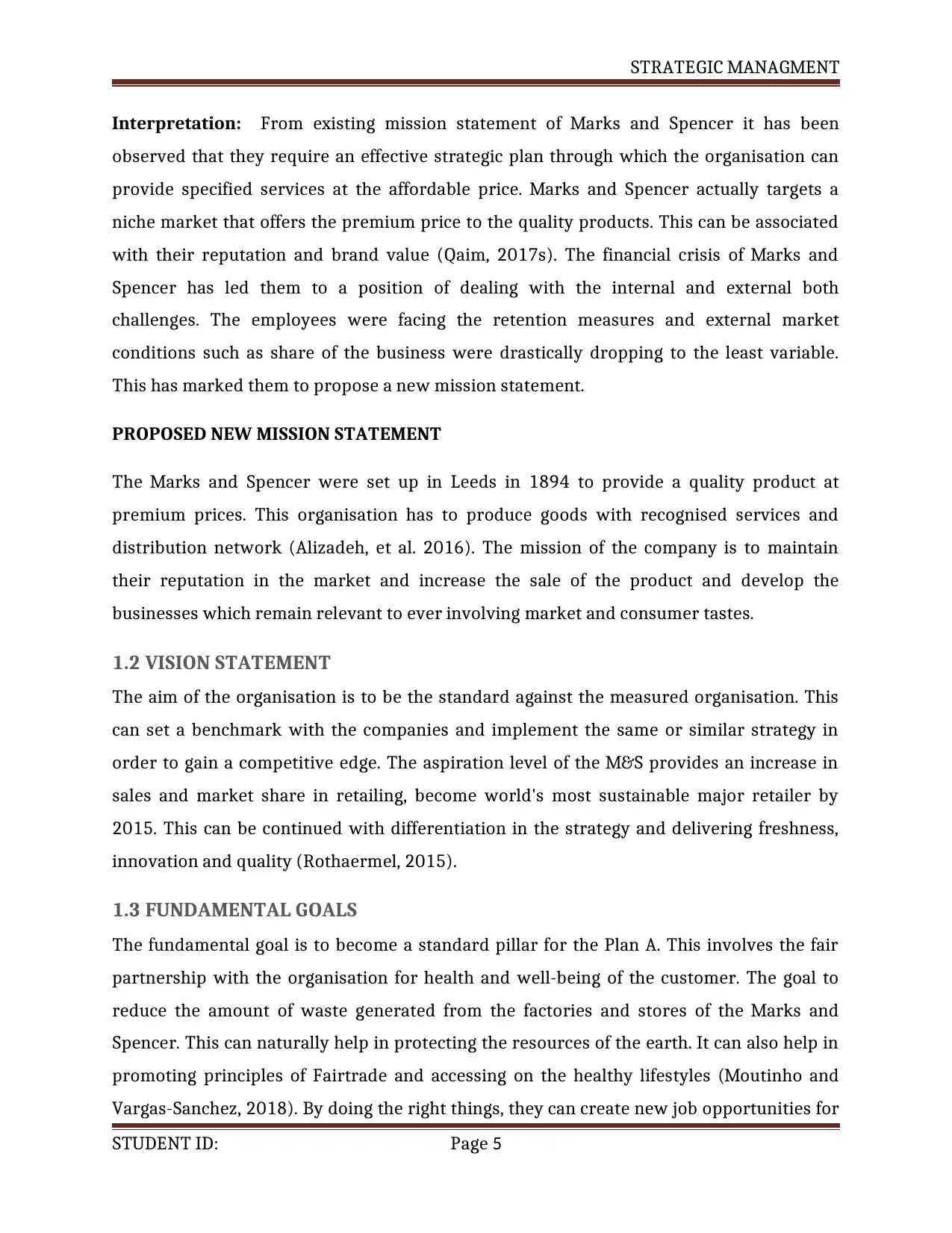
STRATEGIC MANAGMENT
Interpretation: From existing mission statement of Marks and Spencer it has been
observed that they require an effective strategic plan through which the organisation can
provide specified services at the affordable price. Marks and Spencer actually targets a
niche market that offers the premium price to the quality products. This can be associated
with their reputation and brand value (Qaim, 2017s). The financial crisis of Marks and
Spencer has led them to a position of dealing with the internal and external both
challenges. The employees were facing the retention measures and external market
conditions such as share of the business were drastically dropping to the least variable.
This has marked them to propose a new mission statement.
PROPOSED NEW MISSION STATEMENT
The Marks and Spencer were set up in Leeds in 1894 to provide a quality product at
premium prices. This organisation has to produce goods with recognised services and
distribution network (Alizadeh, et al. 2016). The mission of the company is to maintain
their reputation in the market and increase the sale of the product and develop the
businesses which remain relevant to ever involving market and consumer tastes.
1.2 VISION STATEMENT
The aim of the organisation is to be the standard against the measured organisation. This
can set a benchmark with the companies and implement the same or similar strategy in
order to gain a competitive edge. The aspiration level of the M&S provides an increase in
sales and market share in retailing, become world's most sustainable major retailer by
2015. This can be continued with differentiation in the strategy and delivering freshness,
innovation and quality (Rothaermel, 2015).
1.3 FUNDAMENTAL GOALS
The fundamental goal is to become a standard pillar for the Plan A. This involves the fair
partnership with the organisation for health and well-being of the customer. The goal to
reduce the amount of waste generated from the factories and stores of the Marks and
Spencer. This can naturally help in protecting the resources of the earth. It can also help in
promoting principles of Fairtrade and accessing on the healthy lifestyles (Moutinho and
Vargas-Sanchez, 2018). By doing the right things, they can create new job opportunities for
STUDENT ID: Page 5
Interpretation: From existing mission statement of Marks and Spencer it has been
observed that they require an effective strategic plan through which the organisation can
provide specified services at the affordable price. Marks and Spencer actually targets a
niche market that offers the premium price to the quality products. This can be associated
with their reputation and brand value (Qaim, 2017s). The financial crisis of Marks and
Spencer has led them to a position of dealing with the internal and external both
challenges. The employees were facing the retention measures and external market
conditions such as share of the business were drastically dropping to the least variable.
This has marked them to propose a new mission statement.
PROPOSED NEW MISSION STATEMENT
The Marks and Spencer were set up in Leeds in 1894 to provide a quality product at
premium prices. This organisation has to produce goods with recognised services and
distribution network (Alizadeh, et al. 2016). The mission of the company is to maintain
their reputation in the market and increase the sale of the product and develop the
businesses which remain relevant to ever involving market and consumer tastes.
1.2 VISION STATEMENT
The aim of the organisation is to be the standard against the measured organisation. This
can set a benchmark with the companies and implement the same or similar strategy in
order to gain a competitive edge. The aspiration level of the M&S provides an increase in
sales and market share in retailing, become world's most sustainable major retailer by
2015. This can be continued with differentiation in the strategy and delivering freshness,
innovation and quality (Rothaermel, 2015).
1.3 FUNDAMENTAL GOALS
The fundamental goal is to become a standard pillar for the Plan A. This involves the fair
partnership with the organisation for health and well-being of the customer. The goal to
reduce the amount of waste generated from the factories and stores of the Marks and
Spencer. This can naturally help in protecting the resources of the earth. It can also help in
promoting principles of Fairtrade and accessing on the healthy lifestyles (Moutinho and
Vargas-Sanchez, 2018). By doing the right things, they can create new job opportunities for
STUDENT ID: Page 5
⊘ This is a preview!⊘
Do you want full access?
Subscribe today to unlock all pages.

Trusted by 1+ million students worldwide
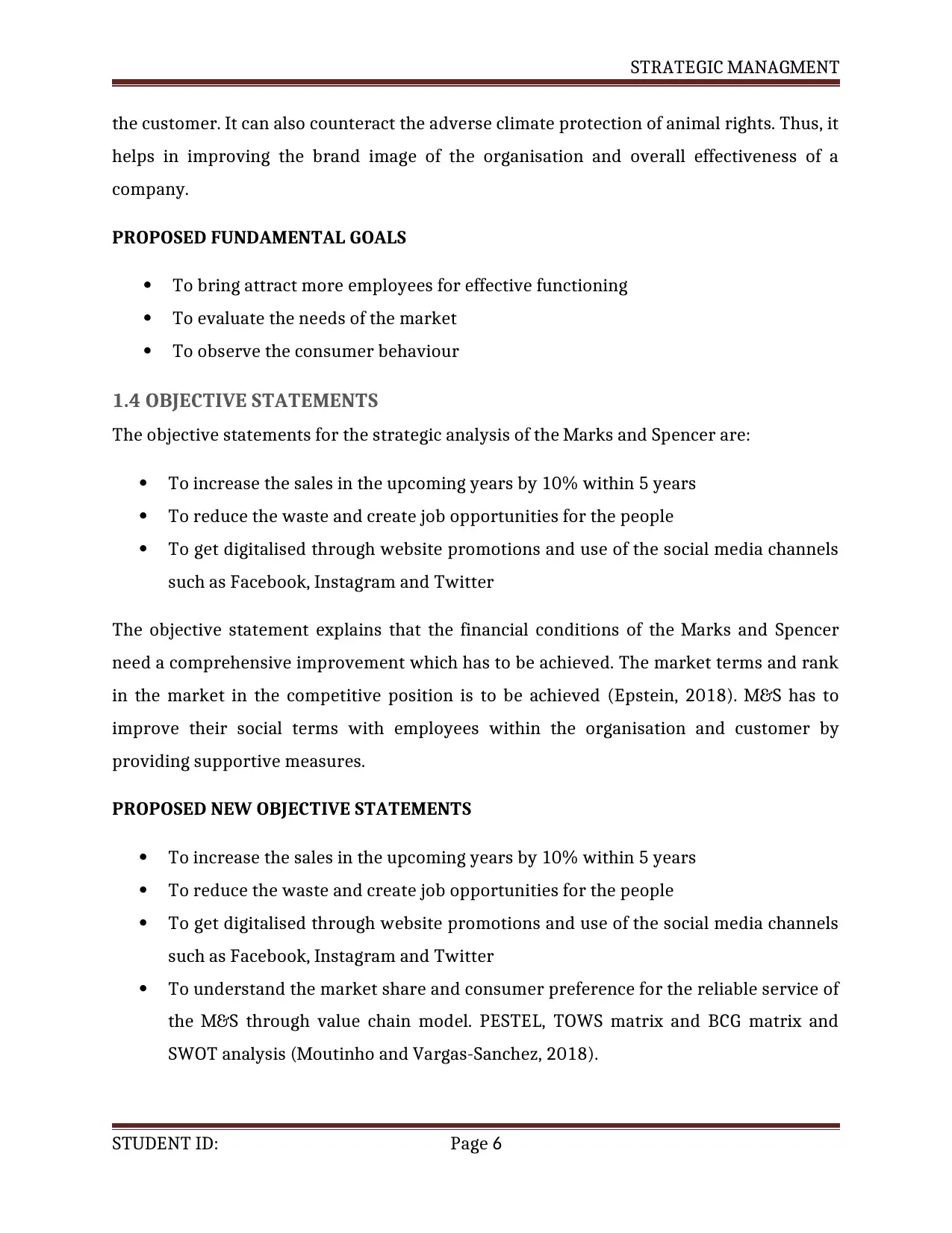
STRATEGIC MANAGMENT
the customer. It can also counteract the adverse climate protection of animal rights. Thus, it
helps in improving the brand image of the organisation and overall effectiveness of a
company.
PROPOSED FUNDAMENTAL GOALS
To bring attract more employees for effective functioning
To evaluate the needs of the market
To observe the consumer behaviour
1.4 OBJECTIVE STATEMENTS
The objective statements for the strategic analysis of the Marks and Spencer are:
To increase the sales in the upcoming years by 10% within 5 years
To reduce the waste and create job opportunities for the people
To get digitalised through website promotions and use of the social media channels
such as Facebook, Instagram and Twitter
The objective statement explains that the financial conditions of the Marks and Spencer
need a comprehensive improvement which has to be achieved. The market terms and rank
in the market in the competitive position is to be achieved (Epstein, 2018). M&S has to
improve their social terms with employees within the organisation and customer by
providing supportive measures.
PROPOSED NEW OBJECTIVE STATEMENTS
To increase the sales in the upcoming years by 10% within 5 years
To reduce the waste and create job opportunities for the people
To get digitalised through website promotions and use of the social media channels
such as Facebook, Instagram and Twitter
To understand the market share and consumer preference for the reliable service of
the M&S through value chain model. PESTEL, TOWS matrix and BCG matrix and
SWOT analysis (Moutinho and Vargas-Sanchez, 2018).
STUDENT ID: Page 6
the customer. It can also counteract the adverse climate protection of animal rights. Thus, it
helps in improving the brand image of the organisation and overall effectiveness of a
company.
PROPOSED FUNDAMENTAL GOALS
To bring attract more employees for effective functioning
To evaluate the needs of the market
To observe the consumer behaviour
1.4 OBJECTIVE STATEMENTS
The objective statements for the strategic analysis of the Marks and Spencer are:
To increase the sales in the upcoming years by 10% within 5 years
To reduce the waste and create job opportunities for the people
To get digitalised through website promotions and use of the social media channels
such as Facebook, Instagram and Twitter
The objective statement explains that the financial conditions of the Marks and Spencer
need a comprehensive improvement which has to be achieved. The market terms and rank
in the market in the competitive position is to be achieved (Epstein, 2018). M&S has to
improve their social terms with employees within the organisation and customer by
providing supportive measures.
PROPOSED NEW OBJECTIVE STATEMENTS
To increase the sales in the upcoming years by 10% within 5 years
To reduce the waste and create job opportunities for the people
To get digitalised through website promotions and use of the social media channels
such as Facebook, Instagram and Twitter
To understand the market share and consumer preference for the reliable service of
the M&S through value chain model. PESTEL, TOWS matrix and BCG matrix and
SWOT analysis (Moutinho and Vargas-Sanchez, 2018).
STUDENT ID: Page 6
Paraphrase This Document
Need a fresh take? Get an instant paraphrase of this document with our AI Paraphraser
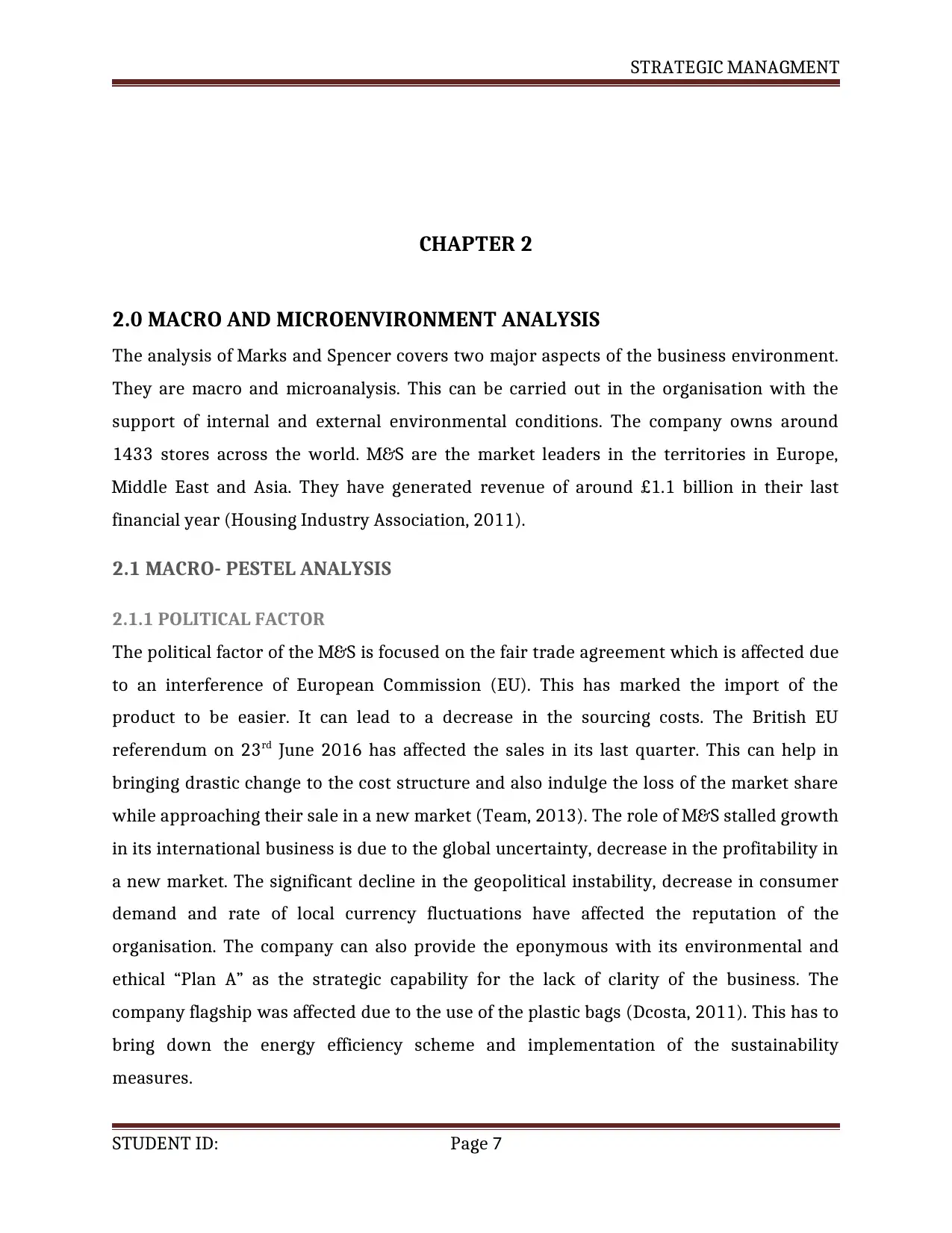
STRATEGIC MANAGMENT
CHAPTER 2
2.0 MACRO AND MICROENVIRONMENT ANALYSIS
The analysis of Marks and Spencer covers two major aspects of the business environment.
They are macro and microanalysis. This can be carried out in the organisation with the
support of internal and external environmental conditions. The company owns around
1433 stores across the world. M&S are the market leaders in the territories in Europe,
Middle East and Asia. They have generated revenue of around £1.1 billion in their last
financial year (Housing Industry Association, 2011).
2.1 MACRO- PESTEL ANALYSIS
2.1.1 POLITICAL FACTOR
The political factor of the M&S is focused on the fair trade agreement which is affected due
to an interference of European Commission (EU). This has marked the import of the
product to be easier. It can lead to a decrease in the sourcing costs. The British EU
referendum on 23rd June 2016 has affected the sales in its last quarter. This can help in
bringing drastic change to the cost structure and also indulge the loss of the market share
while approaching their sale in a new market (Team, 2013). The role of M&S stalled growth
in its international business is due to the global uncertainty, decrease in the profitability in
a new market. The significant decline in the geopolitical instability, decrease in consumer
demand and rate of local currency fluctuations have affected the reputation of the
organisation. The company can also provide the eponymous with its environmental and
ethical “Plan A” as the strategic capability for the lack of clarity of the business. The
company flagship was affected due to the use of the plastic bags (Dcosta, 2011). This has to
bring down the energy efficiency scheme and implementation of the sustainability
measures.
STUDENT ID: Page 7
CHAPTER 2
2.0 MACRO AND MICROENVIRONMENT ANALYSIS
The analysis of Marks and Spencer covers two major aspects of the business environment.
They are macro and microanalysis. This can be carried out in the organisation with the
support of internal and external environmental conditions. The company owns around
1433 stores across the world. M&S are the market leaders in the territories in Europe,
Middle East and Asia. They have generated revenue of around £1.1 billion in their last
financial year (Housing Industry Association, 2011).
2.1 MACRO- PESTEL ANALYSIS
2.1.1 POLITICAL FACTOR
The political factor of the M&S is focused on the fair trade agreement which is affected due
to an interference of European Commission (EU). This has marked the import of the
product to be easier. It can lead to a decrease in the sourcing costs. The British EU
referendum on 23rd June 2016 has affected the sales in its last quarter. This can help in
bringing drastic change to the cost structure and also indulge the loss of the market share
while approaching their sale in a new market (Team, 2013). The role of M&S stalled growth
in its international business is due to the global uncertainty, decrease in the profitability in
a new market. The significant decline in the geopolitical instability, decrease in consumer
demand and rate of local currency fluctuations have affected the reputation of the
organisation. The company can also provide the eponymous with its environmental and
ethical “Plan A” as the strategic capability for the lack of clarity of the business. The
company flagship was affected due to the use of the plastic bags (Dcosta, 2011). This has to
bring down the energy efficiency scheme and implementation of the sustainability
measures.
STUDENT ID: Page 7
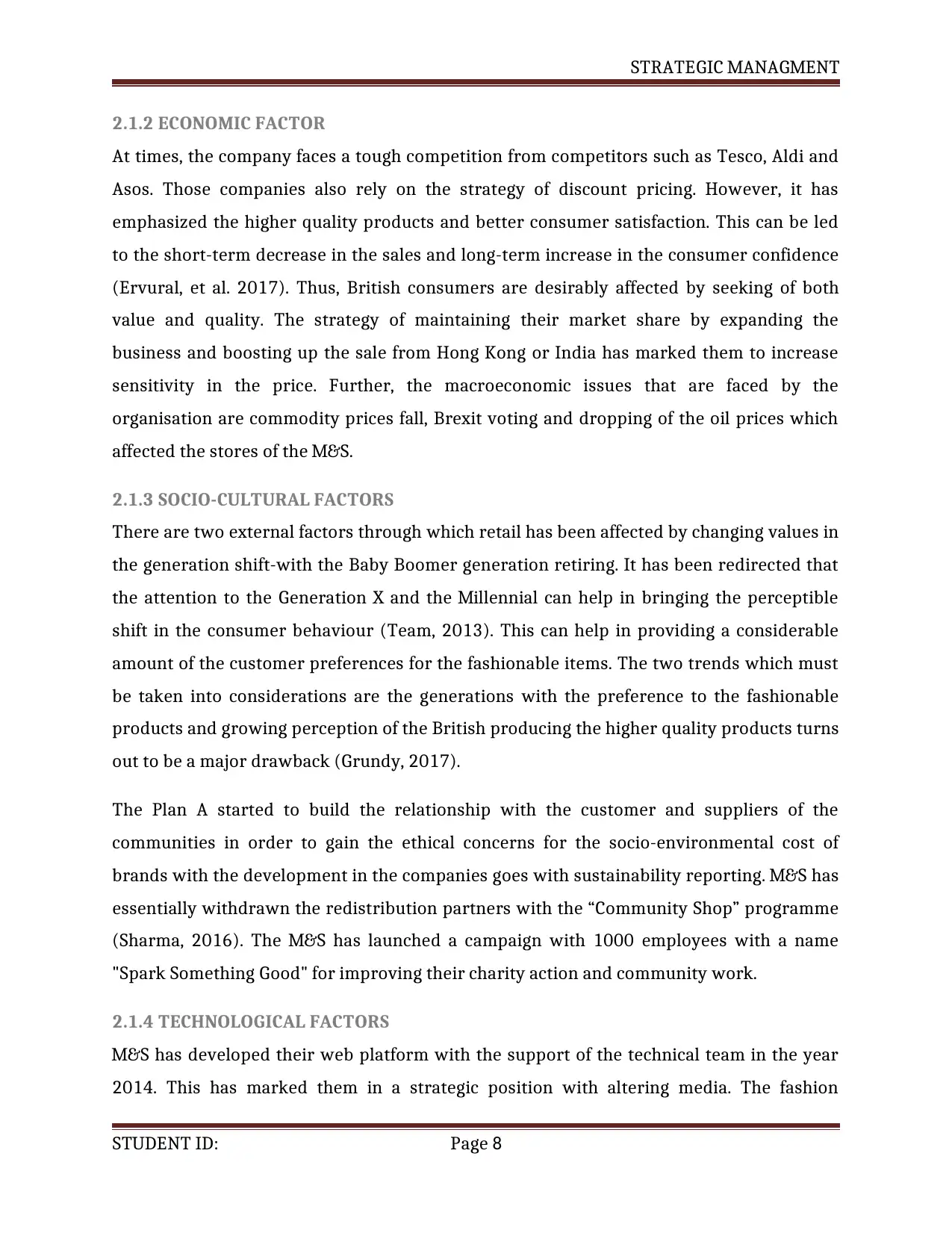
STRATEGIC MANAGMENT
2.1.2 ECONOMIC FACTOR
At times, the company faces a tough competition from competitors such as Tesco, Aldi and
Asos. Those companies also rely on the strategy of discount pricing. However, it has
emphasized the higher quality products and better consumer satisfaction. This can be led
to the short-term decrease in the sales and long-term increase in the consumer confidence
(Ervural, et al. 2017). Thus, British consumers are desirably affected by seeking of both
value and quality. The strategy of maintaining their market share by expanding the
business and boosting up the sale from Hong Kong or India has marked them to increase
sensitivity in the price. Further, the macroeconomic issues that are faced by the
organisation are commodity prices fall, Brexit voting and dropping of the oil prices which
affected the stores of the M&S.
2.1.3 SOCIO-CULTURAL FACTORS
There are two external factors through which retail has been affected by changing values in
the generation shift-with the Baby Boomer generation retiring. It has been redirected that
the attention to the Generation X and the Millennial can help in bringing the perceptible
shift in the consumer behaviour (Team, 2013). This can help in providing a considerable
amount of the customer preferences for the fashionable items. The two trends which must
be taken into considerations are the generations with the preference to the fashionable
products and growing perception of the British producing the higher quality products turns
out to be a major drawback (Grundy, 2017).
The Plan A started to build the relationship with the customer and suppliers of the
communities in order to gain the ethical concerns for the socio-environmental cost of
brands with the development in the companies goes with sustainability reporting. M&S has
essentially withdrawn the redistribution partners with the “Community Shop” programme
(Sharma, 2016). The M&S has launched a campaign with 1000 employees with a name
"Spark Something Good" for improving their charity action and community work.
2.1.4 TECHNOLOGICAL FACTORS
M&S has developed their web platform with the support of the technical team in the year
2014. This has marked them in a strategic position with altering media. The fashion
STUDENT ID: Page 8
2.1.2 ECONOMIC FACTOR
At times, the company faces a tough competition from competitors such as Tesco, Aldi and
Asos. Those companies also rely on the strategy of discount pricing. However, it has
emphasized the higher quality products and better consumer satisfaction. This can be led
to the short-term decrease in the sales and long-term increase in the consumer confidence
(Ervural, et al. 2017). Thus, British consumers are desirably affected by seeking of both
value and quality. The strategy of maintaining their market share by expanding the
business and boosting up the sale from Hong Kong or India has marked them to increase
sensitivity in the price. Further, the macroeconomic issues that are faced by the
organisation are commodity prices fall, Brexit voting and dropping of the oil prices which
affected the stores of the M&S.
2.1.3 SOCIO-CULTURAL FACTORS
There are two external factors through which retail has been affected by changing values in
the generation shift-with the Baby Boomer generation retiring. It has been redirected that
the attention to the Generation X and the Millennial can help in bringing the perceptible
shift in the consumer behaviour (Team, 2013). This can help in providing a considerable
amount of the customer preferences for the fashionable items. The two trends which must
be taken into considerations are the generations with the preference to the fashionable
products and growing perception of the British producing the higher quality products turns
out to be a major drawback (Grundy, 2017).
The Plan A started to build the relationship with the customer and suppliers of the
communities in order to gain the ethical concerns for the socio-environmental cost of
brands with the development in the companies goes with sustainability reporting. M&S has
essentially withdrawn the redistribution partners with the “Community Shop” programme
(Sharma, 2016). The M&S has launched a campaign with 1000 employees with a name
"Spark Something Good" for improving their charity action and community work.
2.1.4 TECHNOLOGICAL FACTORS
M&S has developed their web platform with the support of the technical team in the year
2014. This has marked them in a strategic position with altering media. The fashion
STUDENT ID: Page 8
⊘ This is a preview!⊘
Do you want full access?
Subscribe today to unlock all pages.

Trusted by 1+ million students worldwide
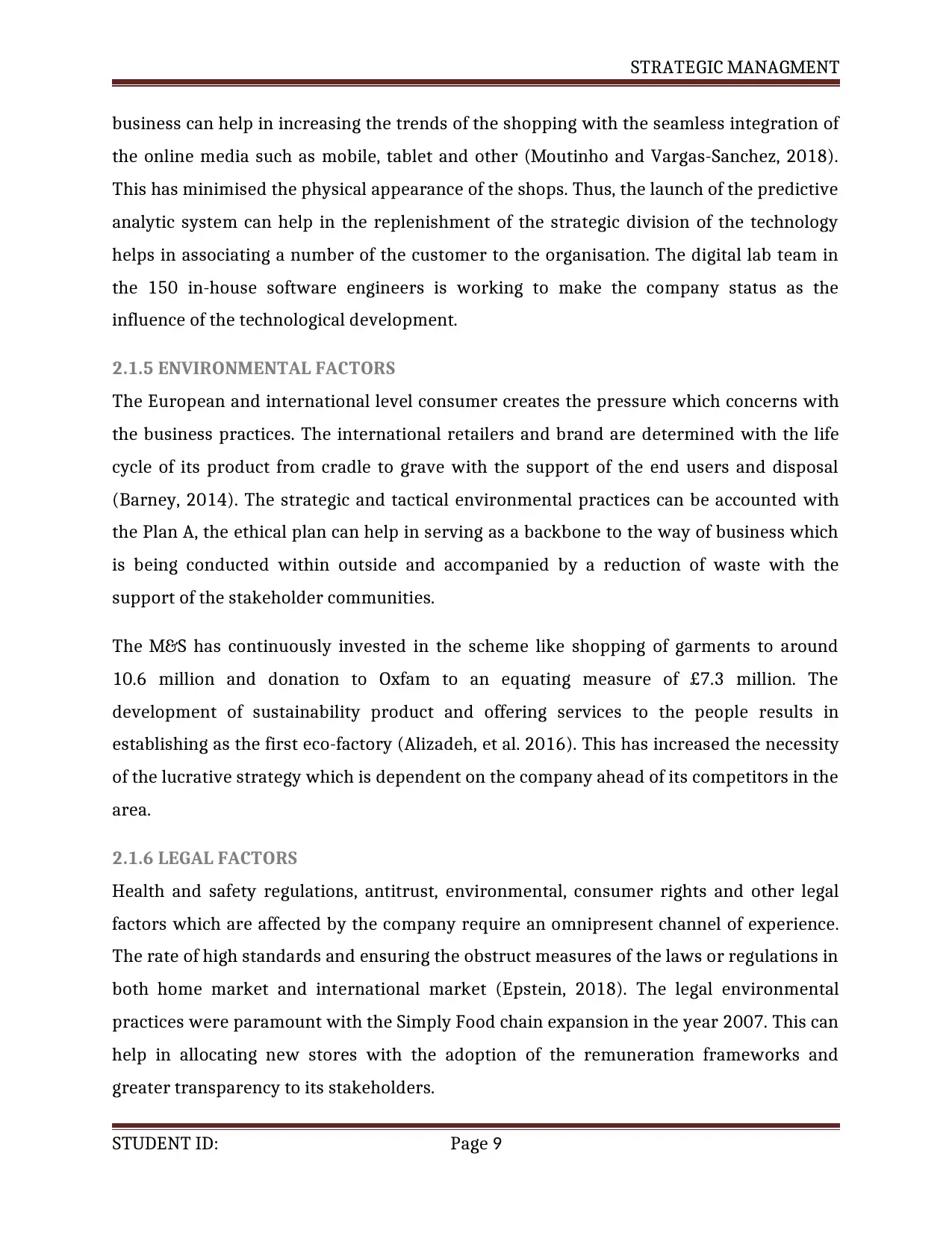
STRATEGIC MANAGMENT
business can help in increasing the trends of the shopping with the seamless integration of
the online media such as mobile, tablet and other (Moutinho and Vargas-Sanchez, 2018).
This has minimised the physical appearance of the shops. Thus, the launch of the predictive
analytic system can help in the replenishment of the strategic division of the technology
helps in associating a number of the customer to the organisation. The digital lab team in
the 150 in-house software engineers is working to make the company status as the
influence of the technological development.
2.1.5 ENVIRONMENTAL FACTORS
The European and international level consumer creates the pressure which concerns with
the business practices. The international retailers and brand are determined with the life
cycle of its product from cradle to grave with the support of the end users and disposal
(Barney, 2014). The strategic and tactical environmental practices can be accounted with
the Plan A, the ethical plan can help in serving as a backbone to the way of business which
is being conducted within outside and accompanied by a reduction of waste with the
support of the stakeholder communities.
The M&S has continuously invested in the scheme like shopping of garments to around
10.6 million and donation to Oxfam to an equating measure of £7.3 million. The
development of sustainability product and offering services to the people results in
establishing as the first eco-factory (Alizadeh, et al. 2016). This has increased the necessity
of the lucrative strategy which is dependent on the company ahead of its competitors in the
area.
2.1.6 LEGAL FACTORS
Health and safety regulations, antitrust, environmental, consumer rights and other legal
factors which are affected by the company require an omnipresent channel of experience.
The rate of high standards and ensuring the obstruct measures of the laws or regulations in
both home market and international market (Epstein, 2018). The legal environmental
practices were paramount with the Simply Food chain expansion in the year 2007. This can
help in allocating new stores with the adoption of the remuneration frameworks and
greater transparency to its stakeholders.
STUDENT ID: Page 9
business can help in increasing the trends of the shopping with the seamless integration of
the online media such as mobile, tablet and other (Moutinho and Vargas-Sanchez, 2018).
This has minimised the physical appearance of the shops. Thus, the launch of the predictive
analytic system can help in the replenishment of the strategic division of the technology
helps in associating a number of the customer to the organisation. The digital lab team in
the 150 in-house software engineers is working to make the company status as the
influence of the technological development.
2.1.5 ENVIRONMENTAL FACTORS
The European and international level consumer creates the pressure which concerns with
the business practices. The international retailers and brand are determined with the life
cycle of its product from cradle to grave with the support of the end users and disposal
(Barney, 2014). The strategic and tactical environmental practices can be accounted with
the Plan A, the ethical plan can help in serving as a backbone to the way of business which
is being conducted within outside and accompanied by a reduction of waste with the
support of the stakeholder communities.
The M&S has continuously invested in the scheme like shopping of garments to around
10.6 million and donation to Oxfam to an equating measure of £7.3 million. The
development of sustainability product and offering services to the people results in
establishing as the first eco-factory (Alizadeh, et al. 2016). This has increased the necessity
of the lucrative strategy which is dependent on the company ahead of its competitors in the
area.
2.1.6 LEGAL FACTORS
Health and safety regulations, antitrust, environmental, consumer rights and other legal
factors which are affected by the company require an omnipresent channel of experience.
The rate of high standards and ensuring the obstruct measures of the laws or regulations in
both home market and international market (Epstein, 2018). The legal environmental
practices were paramount with the Simply Food chain expansion in the year 2007. This can
help in allocating new stores with the adoption of the remuneration frameworks and
greater transparency to its stakeholders.
STUDENT ID: Page 9
Paraphrase This Document
Need a fresh take? Get an instant paraphrase of this document with our AI Paraphraser
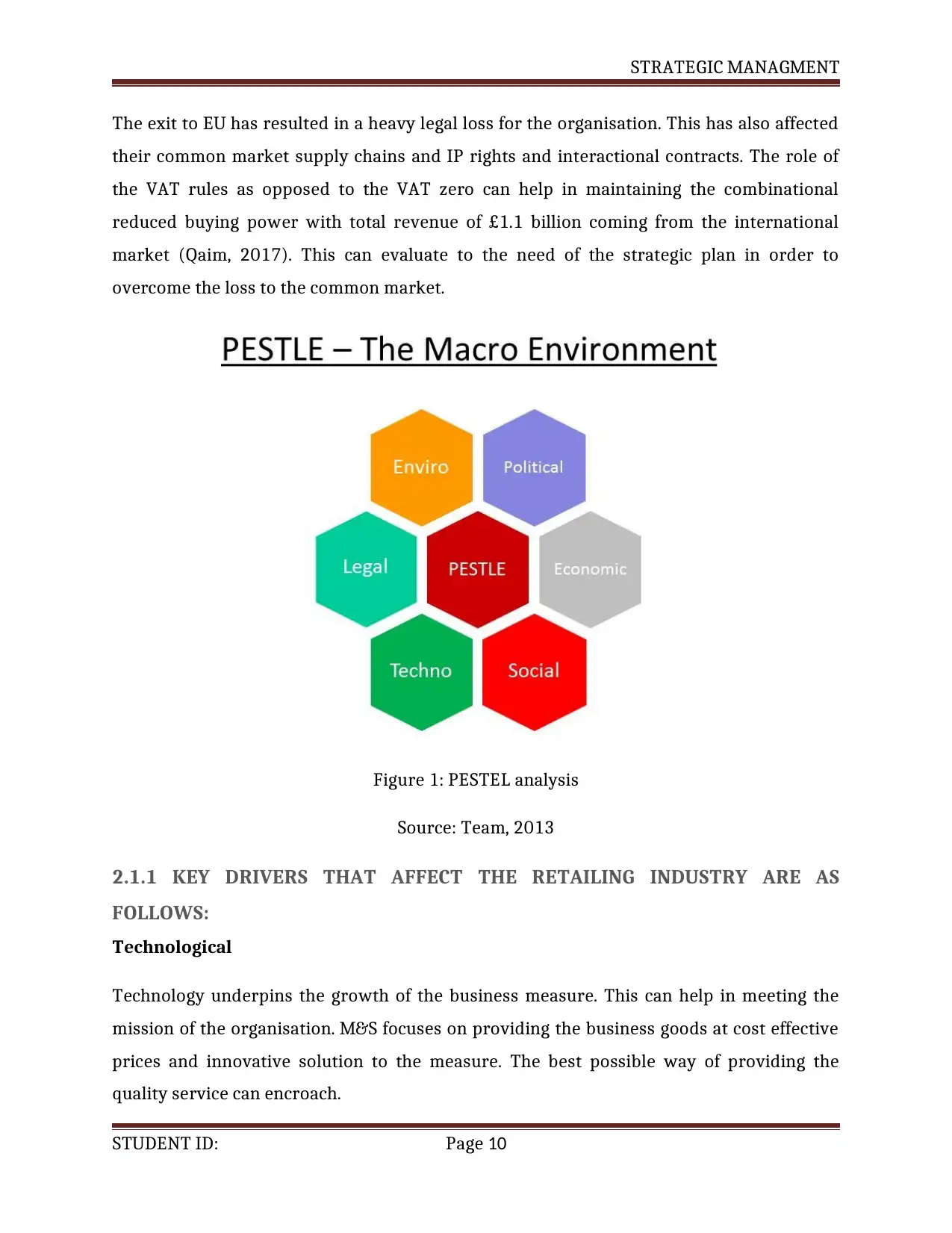
STRATEGIC MANAGMENT
The exit to EU has resulted in a heavy legal loss for the organisation. This has also affected
their common market supply chains and IP rights and interactional contracts. The role of
the VAT rules as opposed to the VAT zero can help in maintaining the combinational
reduced buying power with total revenue of £1.1 billion coming from the international
market (Qaim, 2017). This can evaluate to the need of the strategic plan in order to
overcome the loss to the common market.
Figure 1: PESTEL analysis
Source: Team, 2013
2.1.1 KEY DRIVERS THAT AFFECT THE RETAILING INDUSTRY ARE AS
FOLLOWS:
Technological
Technology underpins the growth of the business measure. This can help in meeting the
mission of the organisation. M&S focuses on providing the business goods at cost effective
prices and innovative solution to the measure. The best possible way of providing the
quality service can encroach.
STUDENT ID: Page 10
The exit to EU has resulted in a heavy legal loss for the organisation. This has also affected
their common market supply chains and IP rights and interactional contracts. The role of
the VAT rules as opposed to the VAT zero can help in maintaining the combinational
reduced buying power with total revenue of £1.1 billion coming from the international
market (Qaim, 2017). This can evaluate to the need of the strategic plan in order to
overcome the loss to the common market.
Figure 1: PESTEL analysis
Source: Team, 2013
2.1.1 KEY DRIVERS THAT AFFECT THE RETAILING INDUSTRY ARE AS
FOLLOWS:
Technological
Technology underpins the growth of the business measure. This can help in meeting the
mission of the organisation. M&S focuses on providing the business goods at cost effective
prices and innovative solution to the measure. The best possible way of providing the
quality service can encroach.
STUDENT ID: Page 10
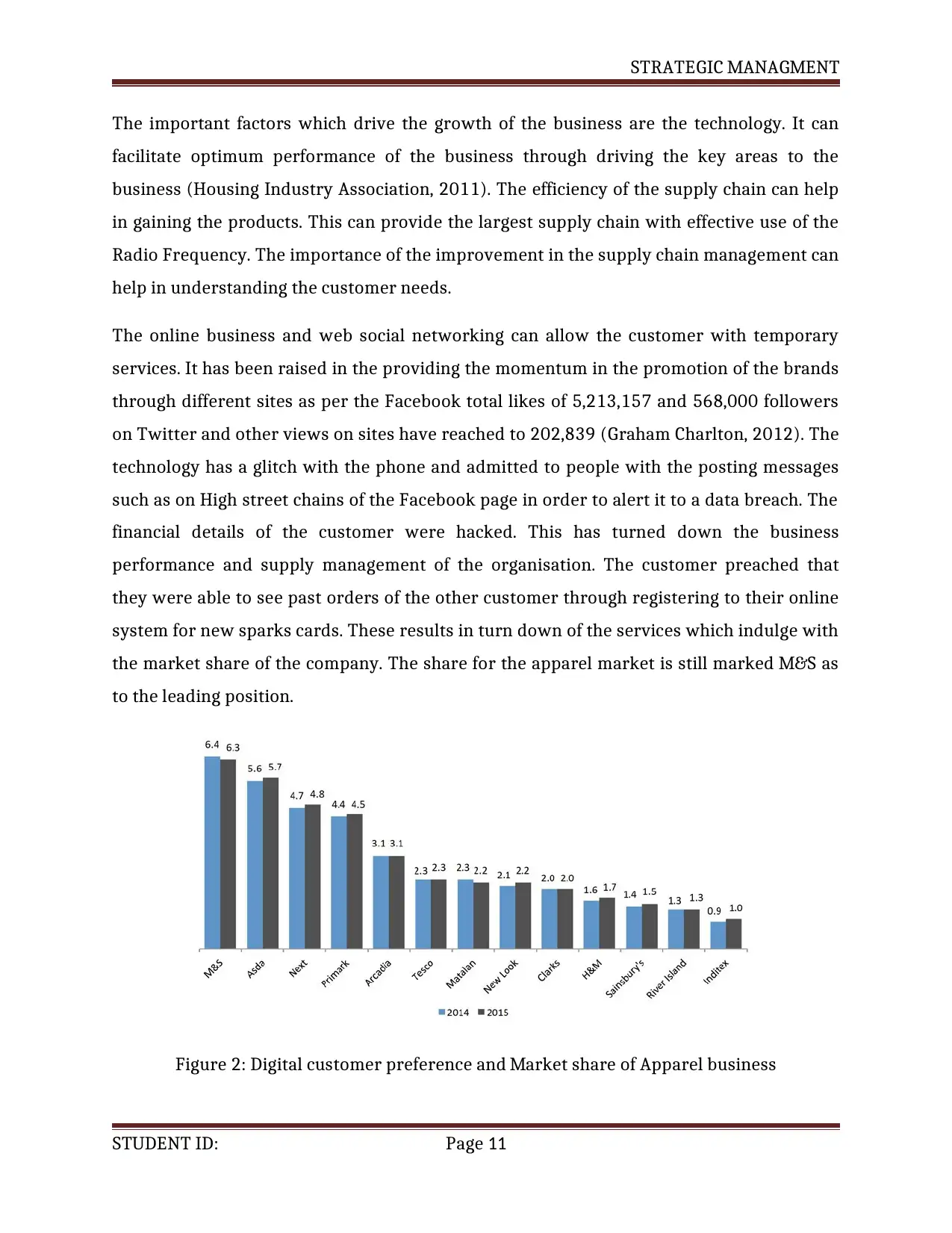
STRATEGIC MANAGMENT
The important factors which drive the growth of the business are the technology. It can
facilitate optimum performance of the business through driving the key areas to the
business (Housing Industry Association, 2011). The efficiency of the supply chain can help
in gaining the products. This can provide the largest supply chain with effective use of the
Radio Frequency. The importance of the improvement in the supply chain management can
help in understanding the customer needs.
The online business and web social networking can allow the customer with temporary
services. It has been raised in the providing the momentum in the promotion of the brands
through different sites as per the Facebook total likes of 5,213,157 and 568,000 followers
on Twitter and other views on sites have reached to 202,839 (Graham Charlton, 2012). The
technology has a glitch with the phone and admitted to people with the posting messages
such as on High street chains of the Facebook page in order to alert it to a data breach. The
financial details of the customer were hacked. This has turned down the business
performance and supply management of the organisation. The customer preached that
they were able to see past orders of the other customer through registering to their online
system for new sparks cards. These results in turn down of the services which indulge with
the market share of the company. The share for the apparel market is still marked M&S as
to the leading position.
Figure 2: Digital customer preference and Market share of Apparel business
STUDENT ID: Page 11
The important factors which drive the growth of the business are the technology. It can
facilitate optimum performance of the business through driving the key areas to the
business (Housing Industry Association, 2011). The efficiency of the supply chain can help
in gaining the products. This can provide the largest supply chain with effective use of the
Radio Frequency. The importance of the improvement in the supply chain management can
help in understanding the customer needs.
The online business and web social networking can allow the customer with temporary
services. It has been raised in the providing the momentum in the promotion of the brands
through different sites as per the Facebook total likes of 5,213,157 and 568,000 followers
on Twitter and other views on sites have reached to 202,839 (Graham Charlton, 2012). The
technology has a glitch with the phone and admitted to people with the posting messages
such as on High street chains of the Facebook page in order to alert it to a data breach. The
financial details of the customer were hacked. This has turned down the business
performance and supply management of the organisation. The customer preached that
they were able to see past orders of the other customer through registering to their online
system for new sparks cards. These results in turn down of the services which indulge with
the market share of the company. The share for the apparel market is still marked M&S as
to the leading position.
Figure 2: Digital customer preference and Market share of Apparel business
STUDENT ID: Page 11
⊘ This is a preview!⊘
Do you want full access?
Subscribe today to unlock all pages.

Trusted by 1+ million students worldwide
1 out of 22
Related Documents
Your All-in-One AI-Powered Toolkit for Academic Success.
+13062052269
info@desklib.com
Available 24*7 on WhatsApp / Email
![[object Object]](/_next/static/media/star-bottom.7253800d.svg)
Unlock your academic potential
Copyright © 2020–2025 A2Z Services. All Rights Reserved. Developed and managed by ZUCOL.





